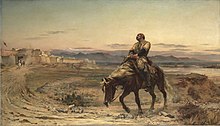William Brydon
William Brydon | |
|---|---|
 Remnants of an Army by Elizabeth Butler | |
| Born | 10 October 1811 London |
| Died | 20 March 1873 (aged 61) Scotland |
| Buried | Rosemarkie churchyard |
| Allegiance | |
| Rank | Assistant Surgeon |
| Unit | Bengal Army |
| Battles / wars | First Anglo-Afghan War, Second Anglo-Burmese War, Indian Rebellion of 1857 |
| Awards | CB |
| Relations | Major General Donald Macintyre VC (brother-in-law) |
William Brydon CB (10 October 1811 – 20 March 1873) was an assistant surgeon in the British East India Company Army during the First Anglo-Afghan War, famous for reportedly being the only member of an army of 4,500 men to reach safety in Jalalabad at the end of the long retreat from Kabul.
He was born in London of Scottish descent. He studied medicine at University College London and at the University of Edinburgh.
Massacre
The British Army began its retreat from Kabul in January 1842, following the killing of the two British representatives there. The nearest British garrison was in Jalalabad, 90 miles (140 km) away, and the army would need to go through mountain passes with the January snow hindering them.
Under the command of Major-General William George Keith Elphinstone, 4,500 military personnel and 12,000 civilian camp followers including wives and children set out for Jalalabad on 6 January 1842. Afghan tribesmen intercepted them and proceeded to massacre them during the next seven days.

The final stand took place at Gandamak on the morning of 13 January 1842 in the snow. Twenty officers and forty-five British soldiers, mostly of the 44th Foot, found themselves surrounded on a hillock. The Afghans attempted to persuade the soldiers that they intended them no harm. Then the sniping began, followed by a series of rushes. Captain Souter wrapped the regimental colours around his body and was dragged into captivity with two or three soldiers. The remainder were shot or cut down. Only six mounted officers escaped, of whom five were killed along the road. On the afternoon of 13 January 1842 the British troops in Jalalabad, watching for their comrades of the Kabul garrison, saw a single figure ride up to the town walls. It was Dr Brydon sr. Part of his skull had been sheared off by an Afghan sword and he survived only because he had stuffed a copy of Blackwood's Magazine into his hat to fight the intense cold weather. The magazine took most of the blow, saving the doctor's life.[1]
Brydon became widely, if inaccurately, famous for being the only survivor of the entire army.[2] In fact, he was not the only European to survive the retreat; about 115 British officers, soldiers, wives and children were captured or taken as hostages and survived to be subsequently released.[3] These included Sir Robert Sale's wife, Lady Florentia Sale, though not Elphinstone who died in captivity. Nor was Brydon the only European to survive the trek from Kabul to Jalalabad without spending time in captivity; by Brydon's own account a "Greek merchant," Mr Baness, also made it to Jalalabad, arriving two days after Brydon but surviving for only one day. In addition a small number of Indian sepoys reached Jalabad on foot over the subsequent weeks.
The episode was made the subject of a famous painting by the Victorian artist Lady Butler, who portrayed an exhausted Dr Brydon approaching the gates of the Jalalabad fort perched on his dying horse (which dropped dead upon arrival in the city).[4] The painting is titled Remnants of an Army.
After the massacre
He fought in the Second Anglo-Burmese War of 1852, when Rangoon was taken.[5]
In 1857, he was a regimental doctor at Lucknow and, along with his wife and children, survived his second siege, that of the Lucknow residency (June – November 1857), in which he was badly wounded in the thigh. He was appointed a Companion of the Order of the Bath (CB) in November 1858.[6] His wife published a memoir of the siege. He died at his home Westfield near Nigg in Ross-shire[5] on 20 March 1873, and is buried in Rosemarkie churchyard alongside his brother-in-law Donald MacIntyre VC[7]
Sources
- Claire E. J. Herrick, "Brydon, William (1811–1873)", Oxford Dictionary of National Biography, Oxford University Press, Sept 2004; online edn, May 2006 accessed 26 Aug 2006
References
- ^ "Article in theaustralian.news.com". Retrieved 24 August 2006. [dead link]
- ^ "Transcripts from CNN". 7 February 2001. Retrieved 24 August 2006.
- ^ Linda Colley, page 350 "Captives - Britain, Empire and the World 1600-1850" ISBN 0-7126-6528-5
- ^ "Mention at theestimate.com". Retrieved 24 August 2006.
- ^ a b Obituary, 14 May (1932). "Brydon's daughter, Mrs Walter Scott". Irish Times.
{{cite news}}: CS1 maint: numeric names: authors list (link) CS1 maint: postscript (link) - ^ "No. 22201". The London Gazette. 16 November 1858.
- ^ Heroes ... and Others, Eric H Malcolm, Cromarty History Society, 2003, ISBN 1-899416-74-5
External links
- Use dmy dates from April 2012
- British Indian Army officers
- British East India Company Army officers
- British surgeons
- Companions of the Order of the Bath
- 1811 births
- 1873 deaths
- British military personnel of the First Anglo-Afghan War
- British military personnel of the Indian Rebellion of 1857
- Alumni of University College London
- Alumni of the University of Edinburgh
- Sole survivors
